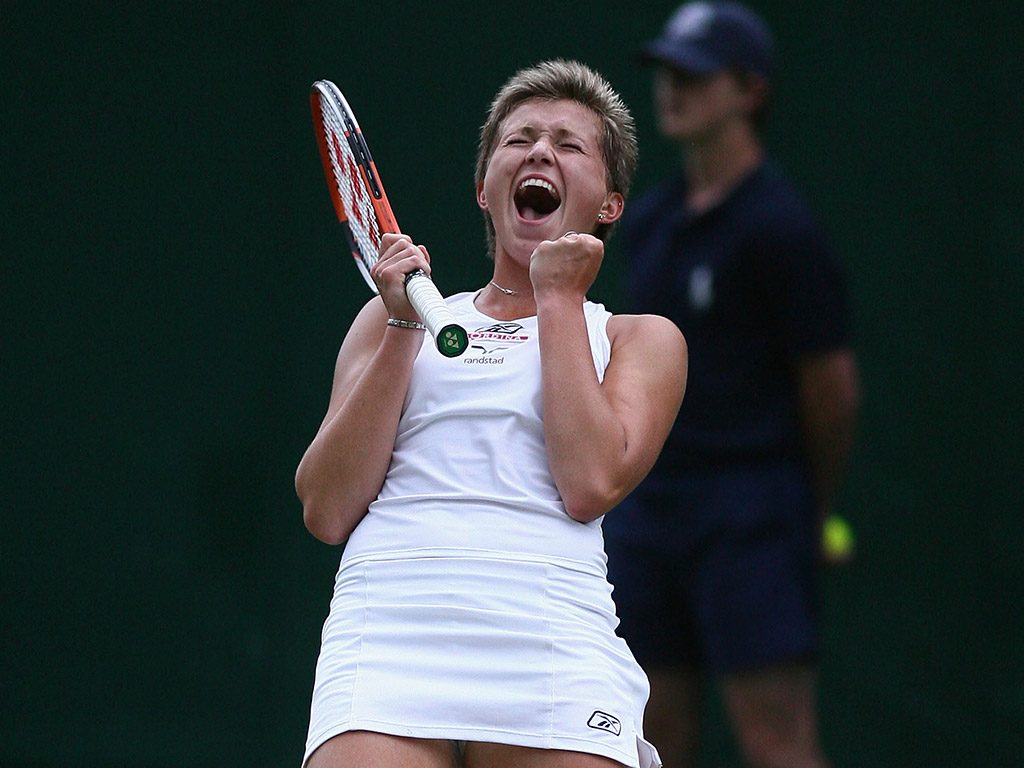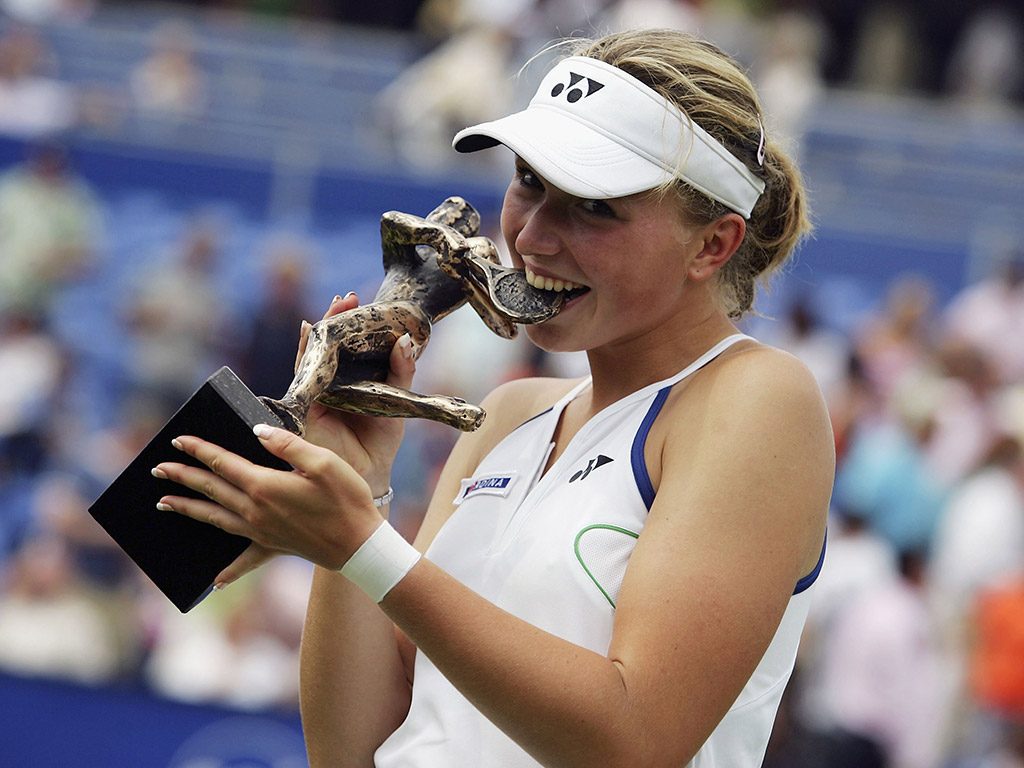Almost a decade ago, a player with a famous name in tennis circles was beginning to make a significant mark on the women’s tour.
Michaella Krajicek – younger sister of Richard, the 1996 Wimbledon champion – in 2007 reached her first Grand Slam quarterfinal at the same venue where her brother excelled. It followed a third-round finish at Roland Garros, and came a season after she won two WTA titles in 2006. In early 2008, she cracked the top 30.
Then, injury intervened. And she’s never since come close to those heights.
Persistent physical ailments can break a player. Marion Bartoli, just a few weeks after winning Wimbledon in 2013, admitted she couldn’t keep putting her body through the rigours of elite-level tennis, and retired immediately. Nicole Vaidisova, a Czech teen phenom of the mid 2000s, made a comeback in 2014 but retired in July this year – chronic injuries again the culprit.
There are many more examples. Yet Krajicek, somehow, persists. “I really love playing tennis, otherwise I would never be doing it still. There’s no chance in hell I would still be doing it,” the 27-year-old laughed, when speaking with tennismash during Wimbledon.
“I feel like with all of these setbacks, eventually like you crash, also in your head … So it’s been an interesting couple of years. I would not say in the most positive way.”

(Krajicek celebrates her fourth-round victory at Wimbledon over Laura Granville, sending her through to a Grand Slam quarterfinal for the first and only time in her career; Getty Images)
Since 2008 – a year beginning with her career-high ranking of No.30 and which ended with her languishing outside the top 200 – Krajicek has endured a stop-start career, vanishing from the tour for long periods due to a range of physical issues, most often affecting her knees.
Her 2012 season was particularly troubling. The WTA website labels it “illness-marred”, a year in which she played just one event after June. Yet Krajicek clarified: “I was feeling a lot of chest pain and it was more created out of … I was a little bit depressed in that time. And I was very stressed. But (the stress) had really a lot to do again with injury.”
From 2013 to 2015, Krajicek averaged just 10 tournaments per year. And she was sidelined for the first five months of 2016, before bobbing up in the Roland Garros qualifying draw.
That particular absence caused her perhaps the most frustration of all. Because in the second half of 2015, for the first time in years, her knee was finally feeling healthy. So, after having enjoyed success on the doubles circuit throughout 2014 and 2015, Krajicek decided to instead put more of her energy into singles.
She reached the semis of an ITF tournament in Winnipeg, Canada before storming through the draw as a qualifier to win the $75,000 ITF title in Albuquerque. She took her winning streak to 12 with victory in Las Vegas, a $50,000 event, and from September to October had shaved her ranking from No.435 to No.185.
But it was during that week in Las Vegas that she began to feel a twinge in her elbow.“I played two more tournaments (in late October) because I thought it was more like muscle, then had it checked out and discovered I had some fluid in it and inflammation. It was not good and it was going to take some time,” she said.
“But I didn’t expect it to take six months – it was supposed to take like a couple of weeks. So that was really a huge setback because I was finally feeling good, especially with my knee – I already had four knee surgeries and after the last one (in 2012) the doctors were not so positive.
“The last six months have been mainly rehab, some fitness; it’s been actually pretty tough – mainly mentally. I really felt like I was playing good and then had to reset and start over.
“So yeah, it’s been a pretty shit year so far (laughter).”
Since returning to action this year, the Dutchwoman has endured mixed results. Her loss in the opening round of French Open qualifying was the result of a complete lack of preparation and it was followed by a loss in her Wimbledon qualifying opener. There was some success on the ITF circuit – a final in Italy, a victory at the $50,000 Lexington tournament – before she fell in the first round of US Open qualifying just a few days ago.
Krajicek, currently ranked No.157, said at Wimbledon that nothing was physically hurting and that her level of both tennis and fitness were steadily improving. She even reached the third round in doubles with Barbora Strycova. Yet mentally, she admitted, the journey has been taxing.
“I think I did pretty good in doubles. I played some semis of some Grand Slams, I got to No.23 for my highest ranking (in March 2015). So it’s actually pretty good. But for me it’s not (enough) … I still feel like I have some more in me in singles but because of all the injuries I feel I’m not catching a break,” she said.
“I have to say when I look back on my career, normally I get pretty emotional about it. What if I had had better health? And sometimes I ask myself questions like, could I have prevented it? With my knee, I couldn’t have because I was born with, like, a bigger meniscus. So they would have had to do surgery anyway but it tore off by itself when I was playing.
“I’ve really tried almost everything and I think the last few years have been by far the most frustrating – even though I’ve played pretty good in doubles it was still a really hard decision for me to accept not to play singles.”

(Krajicek won her last WTA title more than 10 years ago at the 2006 Ordina Open in ‘s-Hertogenbosch, beating Flavia Pennetta, Jelena Jankovic, Elena Dementieva and Dinara Safina en route; Getty Images)
Krajicek could have easily walked away from the game. After all, that’s what most of her contemporaries have done.
Vaidisova is one of them. Other players Krajicek emerged on tour with, like Anna Chakvetadze, Tatiana Golovin and Agnes Szavay, have done the same.
“I’m really close with one or two (of them), so that actually makes it even harder to see that they’re having a normal life outside tennis, no pain, they don’t wake up with a sore something every day. I try not to focus on that but sometimes it’s tough to ignore,” Krajicek said.
“I’ve had only positive reactions (from other players for persevering), except from the friends who have stopped. They’re like: why don’t you stop? They don’t get it. No, seriously, that’s not even a joke – they’re like, why do you keep putting yourself (through this)?”
A sense of unfinished business is perhaps her biggest driver. And that’s because when she does enjoy healthy periods, Krajicek is still a force. Her serve is a major weapon, as is her heavy power from the back of the court. She’s a polished player at net and she’s accumulated plenty of big-match experience.
Should she remain healthy, her focus could then turn to her fitness. “Sometimes it’s more about who is the fittest than who is the better player,” said Krajicek, noting how players’ fitness levels across the board had improved dramatically since her peak season of 2007.
Having for years competed predominantly on the lowly ITF circuit as well as missing months and months of competition, Krajicek doesn’t have the funds to employ a fitness trainer. Her entourage currently numbers just one – her travelling coach/husband, Martin Emmrich.
Yet she remains as confident as ever in her ball-striking.
“If I really compare it to the girls I was playing (a decade ago), like Bartoli, Vaidisova … I would almost say Vaidisova’s more talented than someone else who say is in the top 10 now,” she said.
“Even in doubles I’m playing rallies with the best girls in the world at the moment – like (Elena) Vesnina who’s (in the singles) semis here (at Wimbledon) – and I can handle their pressure, I can handle the ball.
“If I would stay healthy and always going good, I think (with) my game, just the game itself, I definitely have potential for at least top 50.
“I believe that. I don’t want to sound arrogant but I honestly believe that.”